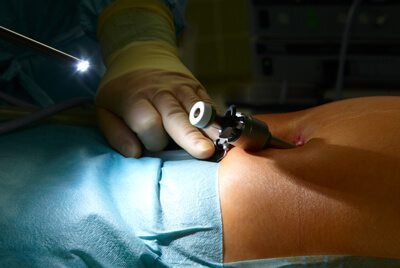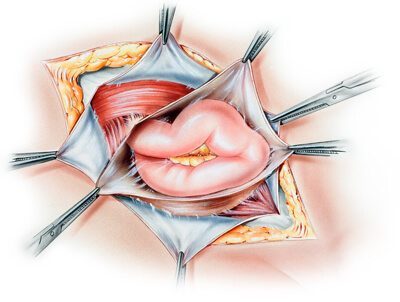Does Hernia Repair Surgery Bring Muscles Back Together
Hernia Mesh Surgery
Surgeons perform hernia mesh surgery by using surgical mesh made from plastic or biologic materials to concur in protruding tissue or organs. The chance of the hernia coming back is less likely if doctors apply hernia mesh. Complications include pain, infection and hernia recurrence.
Surgery is the only way to permanently correct a hernia. Hernia repair surgery is one of the most common surgeries in the United States, and the majority of these repairs use mesh.
For example, doctors perform more than a million hernia surgeries every year in the Us. Well-nigh 800,000 of these surgeries are inguinal hernias — hernias in the groin. Surgeons perform about 90 percent of all inguinal hernia repairs with mesh.
Hernia surgery tin be done with or without mesh. Merely the U.S. Nutrient and Drug Administration has establish that surgical mesh may improve a patient's outcome. It can subtract both the time in surgery and the fourth dimension it takes to recover.
But other factors can play a function, too. These include the blazon of mesh used, the patient's condition and the surgical arroyo. Some types of mesh have been recalled for college failure rates that have led to serious complications and the need for more surgery.
The average cost of hernia surgery in the United States is well-nigh $7,750, according to New Pick Health. This rate may be more or less depending on the type of surgery, where yous get surgery and your insurance plan.
How Hernia Repair with Surgical Mesh Works
Surgical mesh acts equally a flexible scaffold in hernia repair. It can reinforce musculus walls and prevent organs from coming through. This can prevent the condition from worsening. General surgeons or urologists typically perform hernia surgeries.
Surgeons identify the mesh over the open hernia. They utilise sutures, tacks or surgical mucilage to agree the mesh in place. Over time, the patient'south tissue should abound into the small pores in the mesh and strengthen the muscle wall. This creates scar tissue that strengthens the hernia site.
Virtually mesh repairs are permanent, significant the implant remains in the body for the rest of the patient's life.
The time information technology takes to repair a hernia varies from thirty minutes to ii hours. The type of surgery and technique the surgeon uses makes a divergence. Some techniques require local anesthesia and others require general anesthesia.
Dr. Robert Bendavid explains the reasons surgeons are using mesh to repair hernias.
Types of Surgery
There are two types of surgery to implant hernia mesh: laparoscopic repair and open repair.

Laparoscopic hernia repair surgery
Laparoscopic
This is minimally invasive surgery. It is always done under general anesthesia. The surgeon makes several small-scale incisions. He then inserts surgical tools through the openings to implant and secure the mesh.
This procedure allows for a shorter healing time and less blood loss. Merely it is more challenging to perform and costs more.
Surgeons also use laparoscopic repair to ready hernia recurrences, as information technology avoids old scar tissue. Recovery time is one to two weeks. Strenuous practice is generally allowed after about iv weeks.

Illustration showing open up hernia mesh repair
Open up Repair
Surgeons utilise this procedure with or without surgical mesh. Near open hernia repairs apply full general anesthesia. But surgeons may instead use spinal or local anesthesia accompanied by sedation. The surgeon makes an incision virtually the hernia to repair the weak muscle surface area.
This type of surgery cuts through more than muscle and may have more claret loss. Recovery time is nigh three weeks. Strenuous exercise is mostly allowed after six weeks.
Surgical Techniques
There are three master techniques to repair hernias with mesh. Surgeons may choose ane over another because of the patient'due south detail condition. Or they may choose a technique they are more than familiar with.
Most surgeons use the TAPP or TEP techniques. The IPOM technique can sometimes cause adhesions and perforations.
Surgical Techniques:
- TAPP (TRANSABDOMINAL PREPERITONEAL)
Surgeons enter the peritoneum, the thin membrane covering the abdominal organs. They identify the mesh through a small incision.
- TEP (TOTALLY EXTRAPERITONEAL)
Surgeons avert the peritoneal cavity. Surgeons consider TEP more hard to perform than TAPP. But information technology may result in fewer complications.
- IPOM (INTRAPERITONEAL ONLAY MESH TECHNIQUE)
Surgeons enter the peritoneal cavity. They place mesh on the within of the peritoneum. The mesh comes in direct contact with intestines and other organs. This technique is faster and easier to perform than TAPP or TEP. It grew in popularity in the 90s.
Lawsuit Data
Patients experiencing serious complications afterwards hernia mesh surgery are filing lawsuits. Learn more about pending cases.
View Lawsuits
What to Expect Earlier and After Hernia Surgery
Hernia patients should conform for someone to take them to and from the infirmary on the day of the surgery. They will also need someone to stay with them for at least a few days after the surgery.
Doctors may tell patients to cease using aspirin or blood thinners a week earlier surgery. These medicines tin slow clotting and cause excess bleeding during surgery. Using the medicines may dull the healing procedure.
Hernia mesh surgery is usually an outpatient process, meaning that patients do not take to stay overnight in the infirmary. Patients may experience pain as they heal afterward surgery and should look recovery to take several days or longer.
Recovering from hernia mesh surgery tin take several days to several weeks. Information technology depends on the process and the patient'due south status. Patients should tell their md as soon as possible about any problems they observe.
How Much Practice Hernia Surgeries Price?
The cost of a hernia repair in the United States ranges from $3,900 to $12,500 and up, on boilerplate. The national average cost is $vii,750, according to New Pick Health. The biggest factors in price are where you get the surgery, what your health insurance covers and whether you have an open or laparoscopic surgery.
Where Yous Get Your Surgery
Cost profoundly varies depending on what function of the country you take your surgery in and whether yous have information technology in a infirmary or outpatient surgery center. For case, people in Atlanta, Georgia, may pay between $4,700 and $11,100 but people in Phoenix, Arizona, may pay between $5,500 and $12,900.
In full general, surgeries performed in hospitals and other inpatient facilities have a bigger price tag. Hospitals may not disclose all their fees upwards front. Outpatient surgery centers have lower fees, and this leads to fewer costs out of pocket for the patient.
"Most of the fourth dimension, the hospital charges alone tin can be five times more than expensive than the total cost yous can be charged in a surgery clinic," according to Dr. Clay Albrecht, a robotic surgeon.
What Your Insurance Covers
Different insurance plans will have different benefits. The rate your insurance company negotiates with the care provider, whether you are in-network or out-of-network and what type of deductibles you lot have on your policy volition influence your out of pocket costs.
For example, Medicare Role B covers fourscore percent of the cost of outpatient hernia surgery. You would pay 20 per centum plus your deductible. The 2020 deductible is $198.
If yous require a hospital stay, Medicare Function A would cover the hospital care and you would pay your Part A deductible. The Medicare Role A inpatient hospital deductible is $ane,408 for 2020.
Open up Versus Laparoscopic
Open surgeries generally toll less than laparoscopic surgeries considering they may be performed without full general anesthesia and use less medical supplies. Extra supplies may add hundreds or thousands more than to the price.
Serious Complications Can Issue in Hernia Mesh Revision Surgery
Hernia repair with surgical mesh can lead to complications. Surgery is the only way to correct some of the almost serious hernia mesh complications.
A surgeon may have to remove salubrious tissue to repair damage. Surgeons may too have to remove part of the intestines if tissue adheres to the mesh.
Hernia Mesh Complications Reported to the FDA Include:
- Severe hurting
- Serious infections effectually the mesh
- Severe reactions to mesh
- Mesh adhering to internal organs
- Bowel obstruction
- Hernia recurrence
How Do You Know If Your Mesh Failed?
Sometimes hernia mesh might not perform as well as it should. Some types of mesh are decumbent to early on failure. When mesh fails, it causes symptoms.
Symptoms of mesh failure include high fever, influenza-like symptoms, nausea, vomiting, pain, bruising, swelling and difficulty passing gas or stool and difficulty urinating. If you have these symptoms, see your doctor and tell them you accept had hernia mesh surgery.
Some people take filed hernia mesh lawsuits after they claimed failed mesh caused complications.
Source: https://www.drugwatch.com/hernia-mesh/surgery/
Posted by: ellistonparmak.blogspot.com


0 Response to "Does Hernia Repair Surgery Bring Muscles Back Together"
Post a Comment